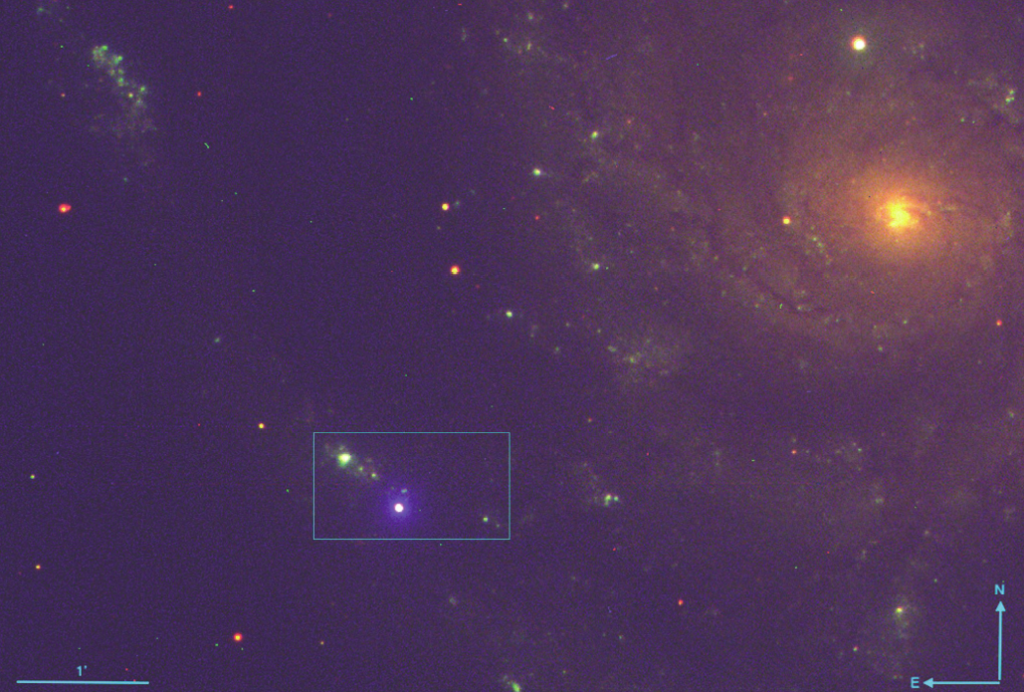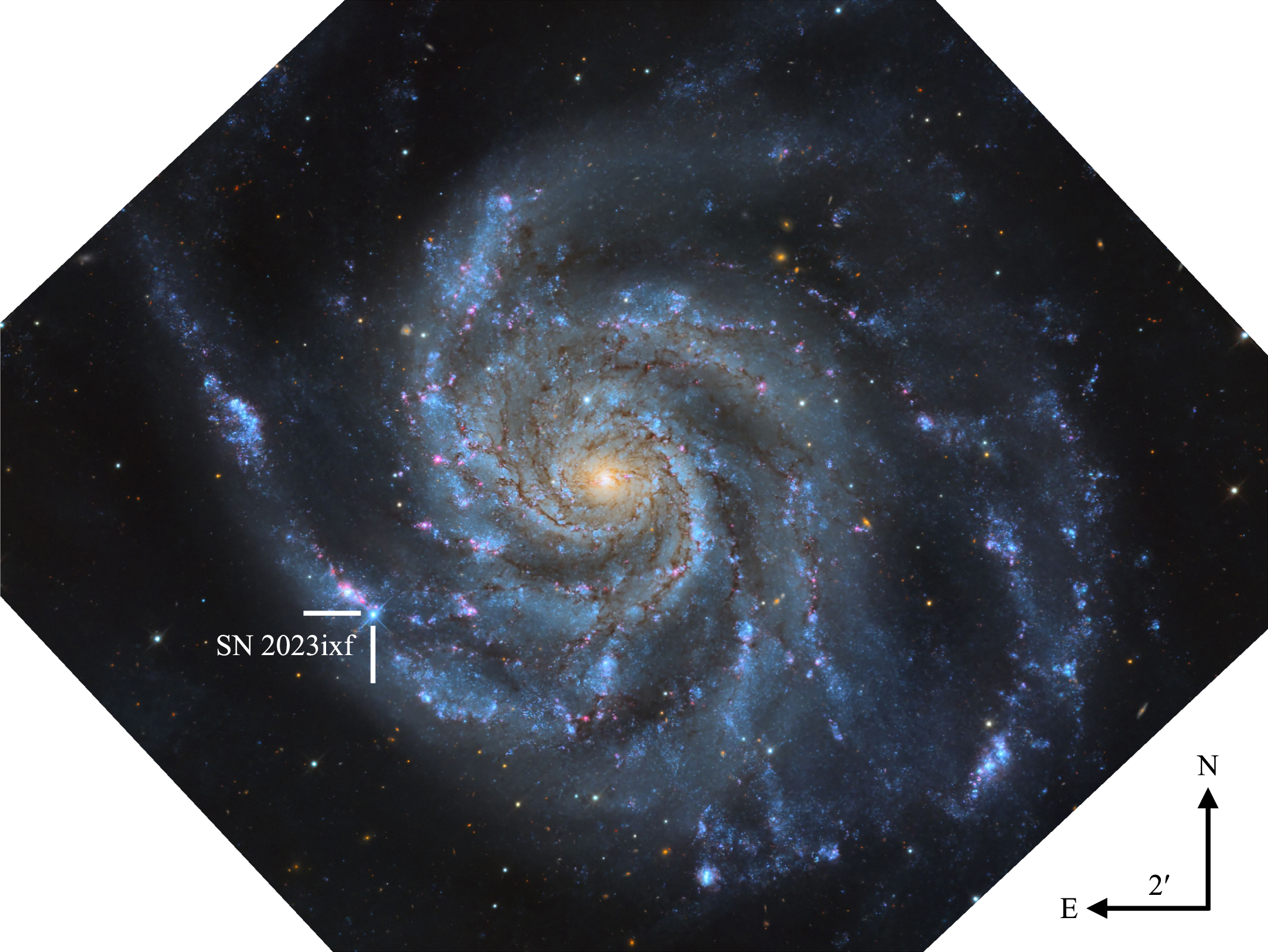Maunakea, Hawaiʻi – Accounts of supernovae – exploding stars – go back thousands of years, and while we know today these events create the building blocks of life itself, there are still unanswered questions about the conditions that cause a star to explode.
Researchers from the Weizmann Institute of Science have now made major headway in better understanding these fascinating phenomena. Using multiple telescopes, including W. M. Keck Observatory on Maunakea, Hawaiʻi Island, they were able to gather data from a once-in-a-lifetime supernova called SN 2023ixf. Their findings are published in today’s edition of the journal Nature.
Until recently, supernovae were considered rare with known occurrences in the Milky Way happening once a century at best, lighting up the night sky with the intensity of 100 million suns; the last observable explosion in our galaxy took place hundreds of years ago.
Advances in telescope technology have since helped identify supernovae in distant galaxies, supplying more data than was previously possible. Still, the same problem persists; since explosions can’t be predicted, astrophysicists are like space archeologists, usually arriving at the scene after the event and trying to piece together information from the remains.
“That’s what makes this particular supernova different,” says PhD student Erez Zimmerman of Prof. Avishay Gal-Yam’s group at Weizmann. “We were able – for the very first time – to closely follow a supernova while its light was emerging from the circumstellar material in which the exploding star was embedded.”
The discovery was equivalent to getting to the scene of the crime while the crime was still taking place.

The scientists admit they were lucky. Gal-Yam’s team applied for research time on NASA’s Hubble Space Telescope, hoping to gather ultraviolet (UV) spectral data on any supernova interacting with its environment. Instead, they got the chance to witness in real-time one of the closest supernovae in decades: a red supergiant exploding in a neighboring galaxy called Messier 101, also known as the Pinwheel Galaxy.
Koichi Itagaki, an amateur astronomer from Japan, discovered SN 2023ixf and reported it on a Friday night, which was in the middle of the weekend in Israel (the work week in Israel is Sunday-Thursday) and right before the weekend in Baltimore’s Space Telescope Science Institute – the operations center for the Hubble Telescope. Complicating things even further, it took place two days before Zimmerman’s wedding. But his team quickly conducted follow-up observations of the supernova, pulling an all-nighter on Friday and delivering the necessary measurements to NASA in the nick of time.
“It’s very rare, as a scientist, that you have to act so swiftly,” says Gal-Yam. “Most scientific projects don’t happen in the middle of the night, but the opportunity arose, and we had no choice but to respond accordingly.”
Not only did they succeed in getting Hubble to assume the right coordinates and angle for recording the necessary data, but because of the explosion’s relative proximity, it turned out Hubble had already made recordings in this sector of the universe many times before. Turning to the NASA archives, Gal-Yam’s team and many other groups were able to acquire data from before the star’s eventual demise – when it was still just a red supergiant in its final stages of life – thus creating the most complete portrait of a supernova ever: a composite of its last days and death.
Observations of SN 2023ixf consisted of UV and X-ray data from NASA’s Hubble and Swift satellites, as well as many of the best telescopes across the globe.
This included spectra captured using three of Keck Observatory’s instruments – the Keck Cosmic Web Imager (KCWI), Deep Imaging and Multi-Object Spectrograph (DEIMOS), and Low Resolution Imaging Spectrometer (LRIS) – with each instrument offering a unique view of the supernova and how it changed over time.
The compilation of high-quality space- and ground-based data enabled the researchers to map out the two outer layers of the exploding star and come up with an extraordinary hypothesis.
“Calculations of the circumstellar material emitted in the explosion, as well as this material’s density and mass before and after the supernova, create a discrepancy, which makes it very likely that the missing mass ended up in a black hole that was formed in the aftermath of the explosion – something that’s usually very hard to determine,” says PhD student Ido Irani of Gal-Yam’s team.
“Stars behave very erratically in their senior years,” says Gal-Yam. “They become unstable and we usually cannot be sure which complex processes occur within them because we always start the forensic process after the fact, when much of the data has already been lost.”
“This study presents a unique opportunity to better understand the mechanisms that lead to the conclusion of a star’s life and the eventual formation of something entirely new,” said Zimmerman.
Scientists may never find out what will happen to the matter that made up Messier 101’s former red supergiant. However, the later stages of the supernova are ongoing and new data are still coming in, which means this study, along with follow-up studies of SN 2023ixf, could provide more insight into these explosive events.
ABOUT KCWI
The Keck Cosmic Web Imager (KCWI) is designed to provide visible band, integral field spectroscopy with moderate to high spectral resolution formats and excellent sky-subtraction. The astronomical seeing and large aperture of the telescope enables studies of the connection between galaxies and the gas in their dark matter halos, stellar relics, star clusters, and lensed galaxies. KCWI covers the blue side of the visible spectrum; the instrument also features the Keck Cosmic Reionization Mapper (KCRM), extending KCWI’s coverage to the red side of the visible spectrum. The combination of KCWI-blue and KCRM provides simultaneous high-efficiency spectral coverage across the entire visible spectrum. Support for KCWI was provided by the National Science Foundation, Heising-Simons Foundation, and Mt. Cuba Astronomical Foundation. Support for KCRM was provided by the National Science Foundation and Mt. Cuba Astronomical Foundation.
ABOUT DEIMOS
The DEep Imaging and Multi-Object Spectrograph (DEIMOS) boasts the largest field of view (16.7arcmin by 5 arcmin) of any of the Keck Observatory instruments, and the largest number of pixels (64 Mpix). It is used primarily in its multi-object mode, obtaining simultaneous spectra of up to 130 galaxies or stars. Astronomers study fields of distant galaxies with DEIMOS, efficiently probing the most distant corners of the universe with high sensitivity.
ABOUT LRIS
The Low Resolution Imaging Spectrometer (LRIS) is a very versatile and ultra-sensitive visible-wavelength imager and spectrograph built at the California Institute of Technology by a team led by Prof. Bev Oke and Prof. Judy Cohen and commissioned in 1993. Since then it has seen two major upgrades to further enhance its capabilities: the addition of a second, blue arm optimized for shorter wavelengths of light and the installation of detectors that are much more sensitive at the longest (red) wavelengths. Each arm is optimized for the wavelengths it covers. This large range of wavelength coverage, combined with the instrument’s high sensitivity, allows the study of everything from comets (which have interesting features in the ultraviolet part of the spectrum), to the blue light from star formation, to the red light of very distant objects. LRIS also records the spectra of up to 50 objects simultaneously, especially useful for studies of clusters of galaxies in the most distant reaches, and earliest times, of the universe. LRIS was used in observing distant supernovae by astronomers who received the Nobel Prize in Physics in 2011 for research determining that the universe was speeding up in its expansion.
ABOUT W. M. KECK OBSERVATORY
The W. M. Keck Observatory telescopes are among the most scientifically productive on Earth. The two 10-meter optical/infrared telescopes atop Maunakea on the Island of Hawaii feature a suite of advanced instruments including imagers, multi-object spectrographs, high-resolution spectrographs, integral-field spectrometers, and world-leading laser guide star adaptive optics systems. Some of the data presented herein were obtained at Keck Observatory, which is a private 501(c) 3 non-profit organization operated as a scientific partnership among the California Institute of Technology, the University of California, and the National Aeronautics and Space Administration. The Observatory was made possible by the generous financial support of the W. M. Keck Foundation. The authors wish to recognize and acknowledge the very significant cultural role and reverence that the summit of Maunakea has always had within the Native Hawaiian community. We are most fortunate to have the opportunity to conduct observations from this mountain.


